Table of Contents
Loading table of contents...
What is Generative BI and Why It Matters in 2025?
Instead of complex dashboards and reports, Gen BI uses AI (LLMs, NLP) to let anyone ask data questions in plain English, generating instant insights, visualizations, and even suggesting next steps. It democratizes data, speeds up analysis, shifts from reactive to proactive insights, and automates tedious tasks, making data more accessible and actionable for the entire organization. While challenges like data quality and accuracy exist, Gen BI promises a future where data interaction is conversational and collaborative, empowering faster, more informed decision-making.
April 20, 2025

AB
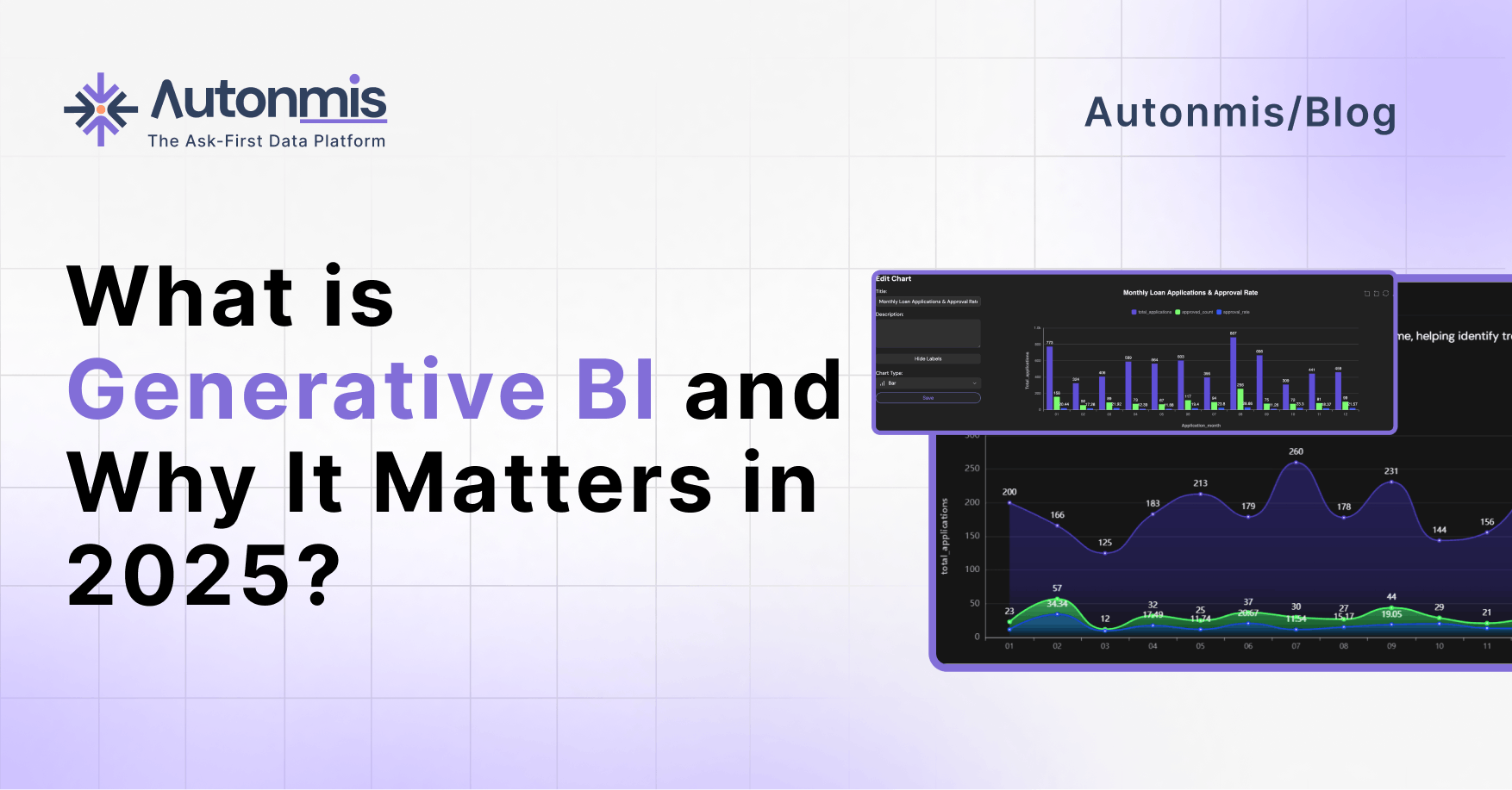
You’ve heard the buzz. "Generative BI" is the new kid on the block, promising to revolutionize how we interact with data and derive insights. But if you're likely cutting through the noise and asking: What is Generative BI? And more importantly, is it just another fleeting trend, or is it fundamentally disrupting the business intelligence landscape we've known for decades?
Spoiler alert: It’s much more the latter.
Traditional Business Intelligence (BI) has been invaluable, helping us understand what happened and why it happened through dashboards, reports, and analytics. It’s been the bedrock of data-driven decision-making. But let's be honest, it often requires specialized skills to build and interpret, can be slow to adapt to new questions, and primarily focuses on analyzing existing, structured data.
Enter Generative BI. It's not just an iteration; it's a paradigm shift.
So, What Exactly is Generative BI?
At its core, Generative Business Intelligence (Gen BI) leverages the power of generative artificial intelligence, particularly Large Language Models (LLMs) and Natural Language Processing (NLP), to transform how users interact with data and generate insights.
Think of it this way:
- Traditional BI: You ask a specific question using predefined metrics and dimensions, and the system pulls up a report or dashboard showing you the answer based on historical data. It’s about querying and presenting.
- Generative BI: You can ask complex questions in natural language, ask for new types of analyses on the fly, have the system generate novel insights, summaries, visualizations, and even suggest next steps or create data narratives. It’s about understanding, creating, and conversing.
Instead of just clicking filters on a dashboard, imagine typing: "Summarize key sales trends for Q1 in the EMEA region for our new product line, identify any anomalies compared to the forecast, and suggest three potential reasons for any deviations." Gen BI aims to deliver that.
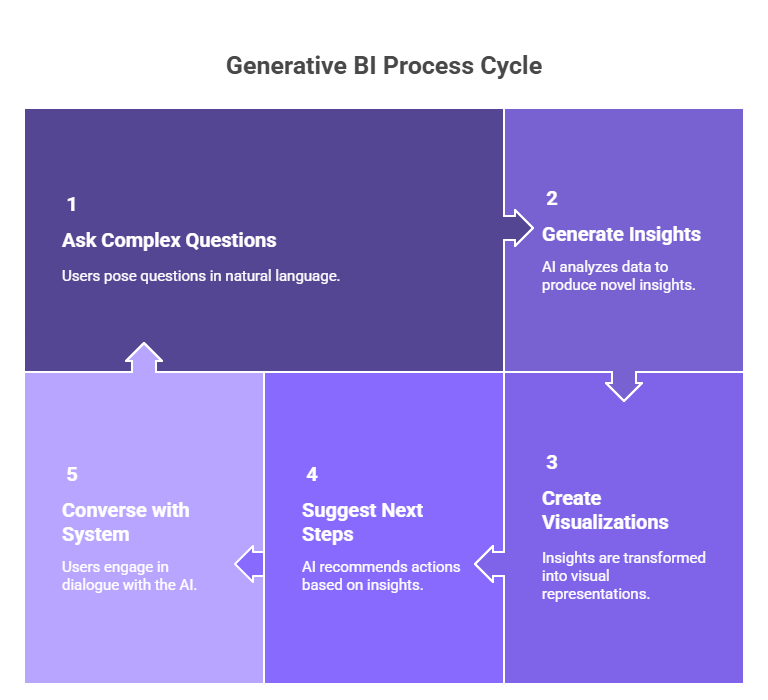
The "How": Key Technologies Powering Gen BI
Gen BI isn't magic; it's built on sophisticated technology:
- Large Language Models (LLMs): These AI models (like GPT-4, Claude, Llama) are trained on vast amounts of text and data, enabling them to understand, generate, and manipulate human language with remarkable fluency. In Gen BI, they interpret user queries and synthesize information into understandable narratives.
- Natural Language Processing (NLP): This allows the system to understand the intent behind your questions, even if they're phrased conversationally or imprecisely.
- Machine Learning (ML): Underlying ML algorithms help identify patterns, anomalies, and correlations in data that might not be obvious, feeding richer context to the LLMs.
- Data Integration & Governance: Crucially, Gen BI still relies on well-structured and governed data. (Perhaps a good place to link to your "What is an AI Data Platform?" blog from autonmis.com).
Checkout: What is an AI Data Platform and How Does It Work?
How Generative BI is Shaking Up the Traditional BI World
The disruptive power of Gen BI isn't just about fancier dashboards. It's fundamentally changing workflows, accessibility, and the very nature of insight generation.
Democratizing Data Access & Insights:
- Traditional: Often requires SQL knowledge or familiarity with specific BI tools. This limits ad-hoc analysis to data analysts or power users.
- Gen BI Disruption: Anyone, regardless of technical skill, can ask questions in plain English (or other languages). This empowers business users, executives, and product managers to directly interrogate data and get answers quickly, reducing reliance on data teams for every small query.
Accelerating Time-to-Insight:
- Traditional: Creating new reports or dashboards can be time-consuming. Modifying existing ones to answer novel questions can involve a backlog.
- Gen BI Disruption: Insights can be generated almost instantly in response to new, unforeseen questions. This agility is crucial in fast-moving markets. Need a quick summary of customer feedback trends from the last 24 hours? Gen BI can deliver.
Moving from Reactive to Proactive & Predictive:
- Traditional: Primarily focused on historical data analysis – what happened.
- Gen BI Disruption: Can not only explain the past but also help generate hypotheses, simulate scenarios ("What if we increased marketing spend in X channel by Y%?"), and even draft initial interpretations or suggest proactive actions.
Enhancing the Depth and Breadth of Analysis:
- Traditional: Often constrained by the way data is structured and the types of visualizations available.
- Gen BI Disruption: Can uncover subtle patterns, correlations, or anomalies that might be missed in standard reports. It can synthesize information from multiple data sources more fluidly and generate textual explanations alongside visualizations, providing richer context.
Automating Tedious Tasks:
- Traditional: Data analysts spend significant time on report generation, data cleansing, and basic interpretation.
- Gen BI Disruption: Can automate the creation of routine reports, generate data quality summaries, and even draft initial commentary for analysts to review and refine. This frees up data professionals to focus on more strategic, complex analysis. Imagine a system that automatically generates a draft of your weekly sales performance slides!
Fostering a True Data Conversation:
- Traditional: Interaction is often one-way – query, then report.
- Gen BI Disruption: Allows for a back-and-forth dialogue. You can ask follow-up questions, request clarifications, or ask the system to look at the data from a different angle, much like brainstorming with a human analyst.
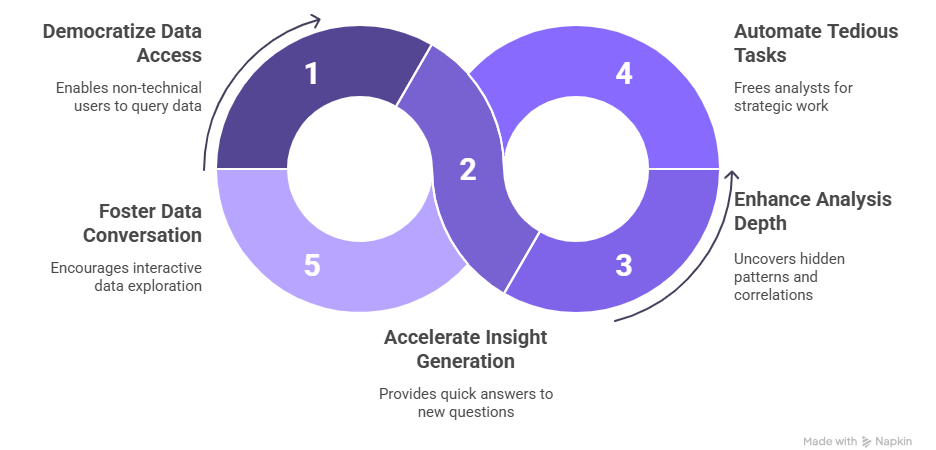
Checkout: Evolving from Scripts to Data Workflow Orchestration
Tangible Benefits of Generative BI for Businesses
This disruption translates into concrete Benefits of Generative BI for Businesses:
- Faster, More Informed Decision-Making: Immediate answers to pressing business questions.
- Increased Productivity: Both for data teams (automating routine tasks) and business users (self-service analytics).
- Improved Data Literacy Across the Organization: Makes data more accessible and understandable for everyone.
- Unlocking New Value from Data: Discovering insights that were previously hidden or too complex to uncover.
- Enhanced Agility and Responsiveness: Quickly adapt to changing market conditions or customer needs.
- Potential for Innovation: By easily exploring data and generating hypotheses, teams can identify new opportunities.
Consider these use cases:
- Sales Leaders: "Generate a forecast for next quarter's sales, highlighting key growth drivers and potential risks based on current pipeline and historical conversion rates."
- Marketing Managers: "Analyze the sentiment of recent customer reviews for Product X and identify the top three features mentioned positively and negatively."
- Operations Managers: "What are the main bottlenecks in our supply chain right now, and what are the simulated impacts of resolving them?"
- Product Managers: "Summarize user engagement patterns for the new feature we launched last week and compare it to the adoption rate of similar features."
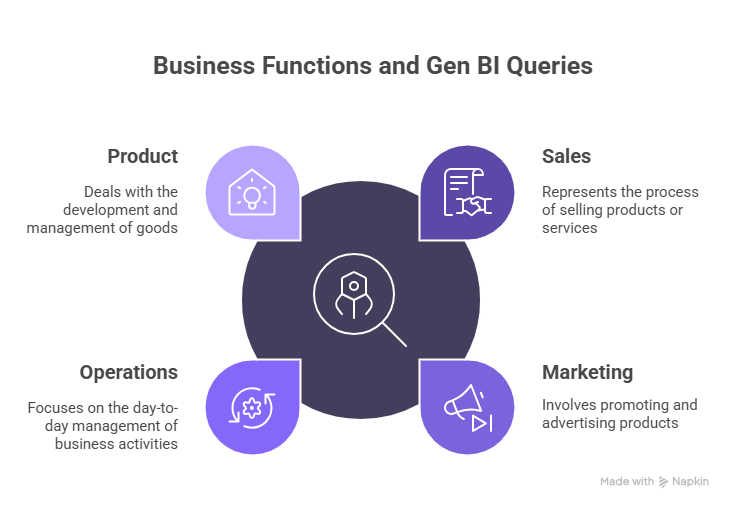
Navigating the Challenges: It's Not All Smooth Sailing (Yet)
While incredibly promising, Gen BI is still an evolving field. As senior data professionals, it's crucial to be aware of the potential hurdles:
- Data Quality & Governance: The "garbage in, garbage out" principle still applies, perhaps even more so. LLMs can be very convincing, even with poor data, so robust data foundations are paramount.
- Accuracy and "Hallucinations": LLMs can sometimes generate plausible-sounding but incorrect information. Mechanisms for fact-checking, verifying against source data, and understanding confidence levels are essential.
- Security and Privacy: Handling sensitive data with LLMs requires careful consideration of data access, masking, and ensuring compliance.
- Integration Complexity: Seamlessly integrating Gen BI tools with existing data warehouses, lakes, and enterprise applications can be a significant undertaking.
- Cost: Training and running large models, or licensing sophisticated Gen BI platforms, can be expensive.
- Change Management & Skills: Teams will need to learn how to best leverage these new tools, and the role of the data analyst may evolve to become more of an "AI collaborator" or "insight curator."
Checkout: What is a Unified Data Platform and Why Do Businesses Need One?
The Future is Conversational, Creative, and Collaborative
Generative BI is not here to replace human analysts or traditional BI entirely. Instead, it's set to augment and enhance our capabilities, making business intelligence more intuitive, accessible, and powerful than ever before.
We're moving towards a future where interacting with data is as simple as having a conversation, where insights are not just discovered but actively generated, and where data truly empowers every level of an organization.
For senior data professionals, PMs, and executives, the journey with Gen BI is just beginning. It's time to explore its potential, understand its implications for your teams and strategies, and start thinking about how this disruptive force can be harnessed to drive real business value.
The question is no longer if Generative BI will change your world, but how you'll lead that change.
It's time to explore its potential, understand its implications for your teams and strategies, and start thinking about how this disruptive force can be harnessed to drive real business value.
For businesses looking to embrace this paradigm shift and empower every team member with conversational data access, explore how platforms like Autonmis are leading the charge. By leveraging AI to simplify complex data operations and deliver instant, natural language insights, Autonmis embodies the future of Generative BI, turning questions into immediate, actionable intelligence.
Recommended Blogs
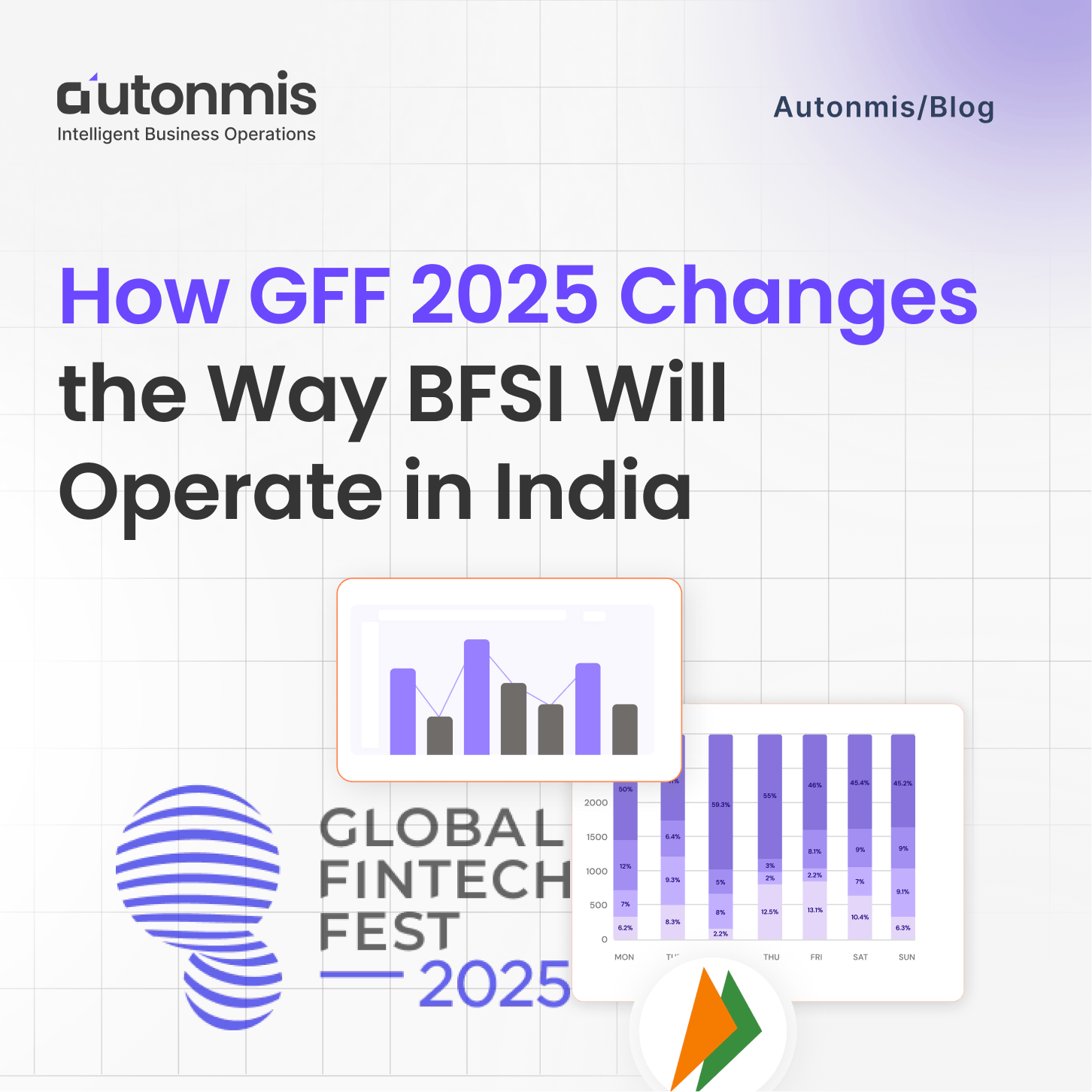
10/17/2025

AB
How GFF 2025 Changes the Way BFSI Will Operate in India

10/13/2025

AB
Top 5 Ways to Improve Lending Operations for Business Growth
Actionable Operational Excellence
Autonmis helps modern teams own their entire operations and data workflow — fast, simple, and cost-effective.